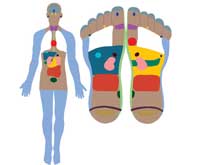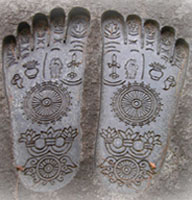Reflexology Explained

What are the Reflexology Points and Areas
In reflexology theory, points and areas on the feet, hands, and ears correspond to specific organs, bones and body systems. Practitioners access these points on the feet and hands (bottom, sides, and top) and the ear (both inside as far as the finger can reach and outside) to affect organs and systems throughout the entire body.
Maps of reflex points have been passed between practitioners across the globe. Understandably, there is not agreement among all reflexologists on all points; however, general agreement does exist on major reflex points. Some scientific documentation of linkages between the skin and internal organs also exists.
To represent how the body systems correspond to one another, reflexologists use reflexology "maps." A good example of a reflexology map exists for the feet. Each foot represents a vertical half of the body:
-
 The left foot corresponds to the left side of the body and all organs, valves, etc. found there.
The left foot corresponds to the left side of the body and all organs, valves, etc. found there.
- The right foot corresponds to the right side of the body and all organs found there. For example, the liver is on the right side of the body, and therefore the corresponding reflex area is on the right foot.
The illustration to the right shows a reflexology map for the feet.
A reflexologist may perform a general, integrated session, or may focus on specific problem areas on the feet, hands or ears. For example, if time is limited and the person really needs to relax, the reflexologist may choose just to work on the ears.
Whatever the specific technique, reflexology theory holds that the practitioner is working to release congestion or stress in the nervous system and balance the body's energy.
How does Reflexology relate to other Therapies
In reflexology theory, points and areas on the feet, hands, and ears correspond to specific organs, bones and body systems. Practitioners access these points on the feet and hands (bottom, sides, and top) and the ear (both inside as far as the finger can reach and outside) to affect organs and systems throughout the entire body.
Maps of reflex points have been passed between practitioners across the globe. Understandably, there is not agreement among all reflexologists on all points; however, general agreement does exist on major reflex points. Some scientific documentation of linkages between the skin and internal organs also exists.
To represent how the body systems correspond to one another, reflexologists use reflexology "maps." A good example of a reflexology map exists for the feet. Each foot represents a vertical half of the body:
-
 The left foot corresponds to the left side of the body and all organs, valves, etc. found there.
The left foot corresponds to the left side of the body and all organs, valves, etc. found there.
- The right foot corresponds to the right side of the body and all organs found there. For example, the liver is on the right side of the body, and therefore the corresponding reflex area is on the right foot.
The illustration to the right shows a reflexology map for the feet.
A reflexologist may perform a general, integrated session, or may focus on specific problem areas on the feet, hands or ears. For example, if time is limited and the person really needs to relax, the reflexologist may choose just to work on the ears.
Whatever the specific technique, reflexology theory holds that the practitioner is working to release congestion or stress in the nervous system and balance the body's energy.
What is a refelxology Treatment
A complete reflexology therapy session uses many different techniques and includes all of the points on both feet (and perhaps the hands and ears). The session generally starts at the fingers or toes, and works down to the heel of the hand or foot, then works the areas on the sides and top.
By working all of the points, the reflexologist addresses internal organs and glands as well as muscle groups, bones, nerve ganglions (solar plexus, brachial plexus) and nerves (sciatic) during a session.
Where does Refelexology Come FromBecause reflexology is an ancient practice, its origin and history is difficult to track. However, reflexology is thought to have been passed down through an oral tradition, and possibly first recorded as a pictograph on the Egyptian tomb of Ankhamor in 2330 BC along with other medical procedures.
2330 BC along with other medical procedures.
Reflexology symbols are also thought to be recorded on the feet of statues of Buddha in India and later China. The Chinese classic, the Yellow Emperor's Classic of Internal Medicine, which was written around 1,000 BC, has a chapter on "Examining Foot Method" and is the beginning of discussions in print about the connection of life force and points and areas on the feet.
It is believed that Marco Polo translated a Chinese massage book into Italian in the 1300s, thus introducing reflexology and massage to Europe. In 1582, a book on an integral element of reflexology called zone therapy was first published in Europe by Dr. Adamus and Dr. A'tatis.
In the United States, William H. Fitzgerald, MD, who is frequently referred to as the father of reflexology, wrote in 1917 about ten vertical zones that extended the length of the body. He found that the application of pressure to a zone that corresponded to the location of an injury could serve as relief of pain during minor surgeries.
Dr. Fitzgerald's work was expanded by Dr. Shelby Riley, who developed a map of horizontal zones going across the body and a detailed map of reflex points on the feet and hands. He also suggested pressure points on the outer ear.
Eunice Ingham, a physiotherapist who worked for Dr. Riley, is another prominent figure in the development of reflexology. In her research with zone therapy's pressure points, she found the feet to be the most sensitive and responsive. She developed the foot maps still in use today and introduced reflexology practices to the non-medical community in the 1930s. Ms. Ingham also designed one of the most commonly used reflexology charts, which has since been refined by her nephew, Dwight Byers, at the International Reflexology Institute.
In 1957, Dr. Paul Nogier recorded a reflex map of points on the outer ear. His work has been expanded by Oleson and Flocco and is now being taught as part of an integrated approach to hand, ear and foot reflexology.



